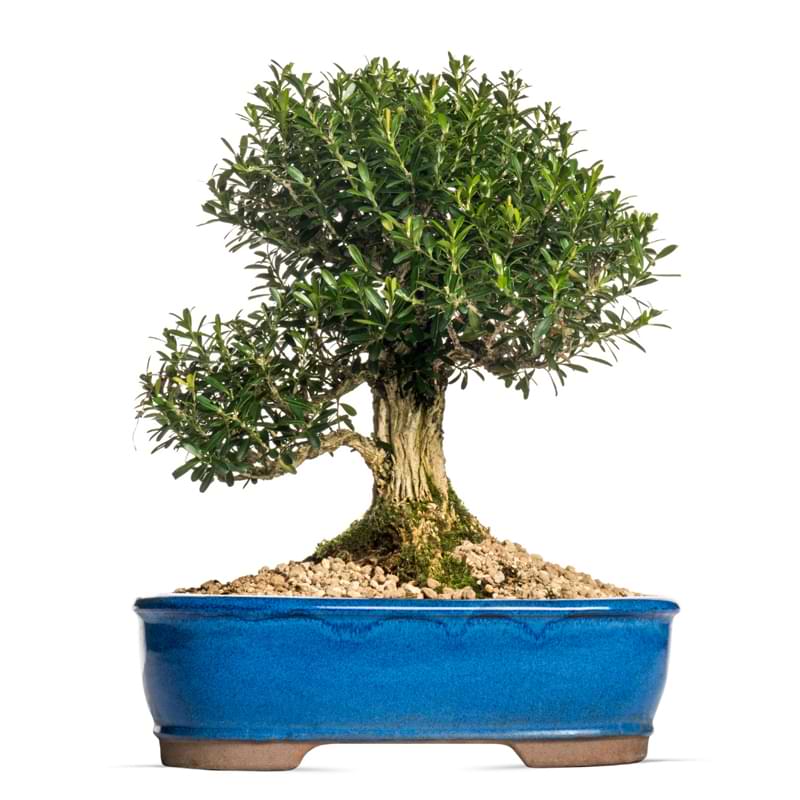A popular shrub in manicured gardens across the world, the evergreen boxwood makes an excellent bonsai specimen. Hardy and mistake-resistant, this beginner-friendly plant is perfect for growers looking for a low-risk foray into the practice.
The robust boxwood bonsai naturally grows in a gnarled fashion and produces deadwood with ease. Its weathered appearance and high tolerance to styling techniques means with little effort you can create a stunning specimen that is truly one of a kind.
While it’s a fabulous beginner plant, the boxwood bonsai still needs care tailored to its unique requirements. But rest assured, once you master the essentials, you’ll have a compelling companion by your side for years to come.
This guide to boxwood bonsai care breaks down the basics and answers a few of the most common beginner FAQs.
Boxwood Bonsai Care Guide & FAQs
FAQ #1: How often should I water boxwood bonsai?
Like most bonsai, boxwood bonsai enjoy ample water—especially during the growing season. But these resilient trees can also endure short periods of low moisture. This makes them particularly well suited for new growers who haven’t quite gotten the hang of their schedule yet.
A good rule of thumb for the boxwood bonsai: shoot for the “Goldilocks” effect. Don’t skimp on watering, but avoid waterlogging the roots; shoot for moisture levels that are just right. Never let the root ball dry out, but avoid letting your plant sit in oversaturated soil.
Bottom-Watering Boxwood Bonsai
Inspect the soil daily to monitor moisture levels. Stick your finger beneath the surface up to your first knuckle: if the soil is bone-dry, it’s time for a bath. To replenish, place the tree and container in a shallow pan or wash basin filled with water. Allow the plant to sit for 5 to 10 minutes, taking up as much moisture as it needs. Remove the bonsai from the water and allow the root ball to drain.
If top-watering: Thoroughly soak the bonsai and soil, wait for several minutes, and repeat the process two more times.
FAQ #2: Can boxwood bonsai be grown indoors?
Nearly all types of bonsai trees are happiest outdoors during the growing season. This includes both of the popular species of boxwood bonsai (common European and Chinese). The delicate Chinese boxwood, however, fares much better indoors than most varieties. Provide adequate light and humidity, and consider trips outside during the summer months, and your Chinese boxwood will grow healthy and strong.
The tough European boxwood, however, appreciates a residency in the great outdoors. See Types of Boxwood Bonsai below for more information about overwintering each species. To learn more about the best indoor plants and how to care for them, explore our beginner’s guide to indoor bonsai.
FAQ #3: How much light do boxwood bonsai need?
Part of what makes a boxwood bonsai such a wonderful tree is its tolerance for varying levels of light. Like most trees, they enjoy a fair amount of sunlight, particularly during the growing season. But they’ll get by just fine in semi-shade, or indoor spaces with lower light. In fact, during the harshest summer spells, your tree will thank you for a shady afternoon reprieve. (Their sensitive evergreen leaves can burn in direct, scorching sunlight.)
FAQ #4: How do you prune boxwood bonsai?
Boxwood wood is very hard and durable, which makes it a popular choice for wind instruments, chess pieces, and other carved specialty items. And when it comes to pruning and shaping your boxwood bonsai, these same qualities boost tolerance and resilience. A natural shrub, boxwood bonsai also shape well to many bonsai styles—including some of the more creative undertakings.
Begin heavy pruning in the mid spring as new growth appears. Start by removing damaged or diseased branches, or limbs growing criss-cross or out of place. Next, assess your tree, and which branches will need to be trimmed back to maintain the desired shape. Cut just past budding leaf clusters to prevent unsightly blunt edges. As the growing season progresses, thinning the outer canopy can provide more light to sun-starved inner foliage.
Shaping Boxwood Bonsai
Boxwoods have dense, rough bark perfectly suited for unique bonsai shapes. But their hard wood means that the branches are difficult to bend once mature, so you’ll want to start wiring while the shoots are young and flexible. You can leave wiring on throughout the growing season to guide the stubborn branches, but take care not to damage the light-colored bark. Any marrs or bites will remain visible for years.
Learn more: Master wiring techniques with 6 Easy Steps to Wire Bonsai Trees.
FAQ #4: How often should I repot boxwood bonsai?
Boxwoods have naturally dense and shallow root systems, and tolerate repotting quite well. (Hardiness is a theme with this plant!) Depending on its age, your tree should be repotted every two to five years. You’ll want to repot more frequently when the tree is under six, and extend time between potting as it becomes more established.
Boxwoods may be repotted throughout the year but seem to do best when they’re emerging from or preparing for winter dormancy. After repotting, provide a shady location for the tree to relax and recover.
Repot? Fear not! This beginner-friendly guide to repotting will show you how.
FAQ #4: Can you defoliate boxwood bonsai?
Boxwoods naturally grow small leaves, which gives them a head start as bonsai specimens. However, as your tree becomes more established, you may want to stunt the size of its leaves even further. In this case, you may wonder if you can defoliate boxwood bonsai. The answer is: yes, carefully.
Defoliation involves removing some or all of your tree’s leaves after they’ve sprouted for the growing season. In response, your tree will grow a second, smaller set to replace them. This can be stressful, and is best done in early June so your tree can fully recover before winter.
Remove new buds from the base as they swell, leaving only the top two leaf pairs. New, tiny buds will emerge from the base of the severed buds. Your tree should be quite dense with ample shoots and small leaves, which can be thinned to achieve the desired appearance.
PSA: A boxwood is an evergreen shrub, so never fully defoliate it. Full defoliation can result in a tree never regaining its leaves.
FAQ #5: Are boxwood bonsai poisonous?
Both bonsai and pets are beloved members of the family. The problem? Dogs and cats don’t know bonsai trees aren’t a snack! Unfortunately, many species of bonsai are poisonous—including all parts of the boxwood. If your pet nibbles on the bonsai, the effects can range from stomachache to fatality, depending on the dose.
As a pet owner, your best practice is to completely separate bonsai and pets. Consider establishing a specific room for your trees, placing high on the mantle, or growing exclusively outdoors if you have an indoor pet. Learn more with our guide to bonsai trees and cats.
Suspect your pet has ingested boxwood bonsai? Contact your vet or call the pet poison control hotline immediately.

Types of Boxwood Bonsai
You can find over 70 types of boxwood trees across the planet, but two main species reign supreme in bonsai: the Chinese and European common boxwood. While the two species have similarities, it’s important to understand their notable differences to provide proper care.
European Common Boxwood (Buxus sempervirens)
European boxwood is a common landscaping shrub throughout England and other parts of Europe. It’s readily trainable and the faster growing of the two species. Common boxwood prefers to grow outdoors and is frost tolerant. However, if temperatures dip below freezing, you’ll want to move it into a cool place to overwinter.
Common boxwood goes completely dormant in the winter months, meaning it will not need to be fertilized. An evergreen shrub, your boxwood will retain its leaves all winter. Slight frosts may cause the leaves to yellow or pale, but they’ll bounce back in the spring.
Chinese Boxwood (Buxus harlandii)
The Chinese boxwood, while hardy, is more delicate than its European cousin. This species does well in indoor conditions, but prefers to live outside during the warmer months. In no case should a Chinese boxwood overwinter outdoors; instead, provide a cool room with temperatures around 50 degrees Fahrenheit. These trees do not go fully dormant, and will need to be fertilized monthly to replenish nutrients.
Have another question about caring for your boxwood bonsai? Join the conversation in our Facebook group.
Bonsai With Us!
The Bonsai Resource Center is here to help you learn about boxwood bonsai and provide you with the tools you need to keep your tree healthy and strong. Explore our other articles, visit our online shop, and connect with other bonsai lovers in our Facebook group to learn everything you need to know about this rewarding hobby!
More Bonsai Tree Resources
6 Easy Steps to Wire Bonsai Trees
Growers Guide: How to Make a Bonsai Tree



